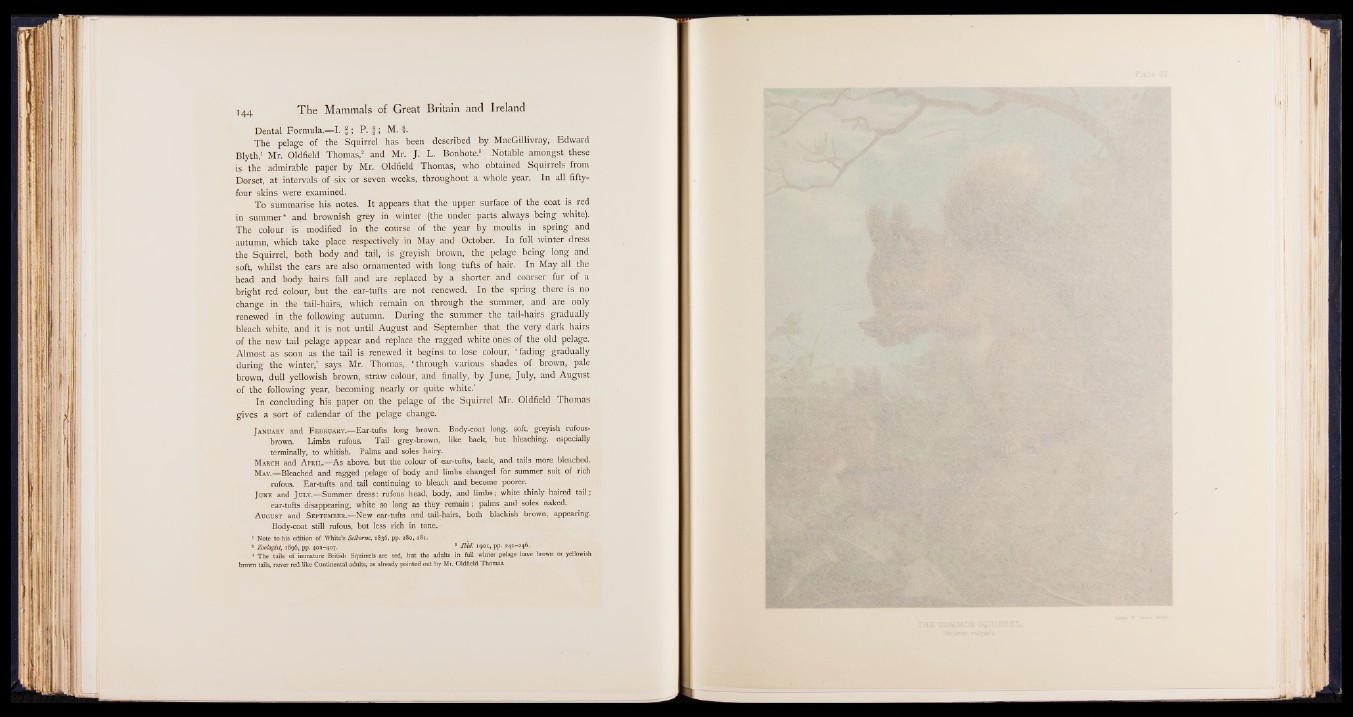
Dental Formula.—I. § ; P. f ; M. $.
The pelage of the Squirrel has been described by MacGillivray, Edward
Blyth,1 Mr. Oldfield Thomas,2 and Mr. J . L. Bonhote.8 Notable amongst these
is the admirable paper by Mr. Oldfield Thomas, who obtained Squirrels from
Dorset, at intervals of six .or seven weeks, throughout a whole year. In all fifty-
four skins were examined.
To summarise his notes. It appears that the upper surface of the coat is red
in summer4 and brownish grey in winter (the under parts always being white).
The colour is modified in the course of the year by moults in spring and
autumn, which take place respectively in May and October. In full winter dress
the Squirrel, both body and tail, is greyish brown, the pelage being long and
soft, whilst the ears are also ornamented with long tufts of hair. In May all the
head and body hairs fall and are replaced by a shorter and coarser fur of a
bright red colour, but the ear-tufts are not renewed. In the spring there is no
change in the tail-hairs, which remain on through the summer, and are only
renewed in the following autumn. During the summer the tail-hairs gradually
bleach white, and it is not until August and September that the very dark hairs
of the new tail pelage appear and replace the ragged white ones of the old pelage.
Almost as soon as the tail is renewed it begins to lose colour, ‘ fading gradually
during the winter,’ says Mr. Thomas, ‘ through various shades of brown, pale
brown, dull yellowish brown, straw colour, and finally, by June, July, and August
of the following year, becoming nearly or quite white.’
In concluding his paper on the pelage of the Squirrel Mr. Oldfield Thomas
gives a sort of calendar of the pelage change.
J anuary and F ebru ar y .—Ear-tufts long brown. Body-coat long, soft, greyish rufous-
brown. Limbs rufous. Tail grey-brown, like back, but bleaching, especially
terminally, to whitish. Palms and soles hairy.
M arch and A pr il .—As above, but the colour of ear-tufts, back, and tails more bleached.
Ma y .— Bleached and ragged pelage of body and limbs changed for summer suit of rich
rufous. Ear-tufts and tail continuing to bleach and become poorer.
J u n e and J u l y .—Summer dress: rufous head, body, and limbs; white thinly haired tail;
ear-tufts disappearing, white so long as they remain ; palms and soles naked.
A ugust and S eptember.—New ear-tufts and tail-hairs, both blackish brown, appearing.
Body-coat still rufous, but less rich in tone. •
1 Note to his edition of White’s Selbome, 1836, pp. 280, 281.
* Zoologist, 1896, pp. 401-407. 3 Ibid. 1901, pp. 241-246.
« The tails of immature British Squirrels are red, but the adults in full winter pelage have brown or yellowish
brown tails, never red like Continental adults, as already pointed out by Mr. Oldfield Thomas.